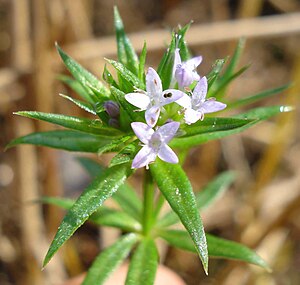Field redness
| Field redness | ||||||||||||
|---|---|---|---|---|---|---|---|---|---|---|---|---|

Field redness ( Sherardia arvensis ) |
||||||||||||
| Systematics | ||||||||||||
|
||||||||||||
| Scientific name of the genus | ||||||||||||
| Sherardia | ||||||||||||
| L. | ||||||||||||
| Scientific name of the species | ||||||||||||
| Sherardia arvensis | ||||||||||||
| L. |
The sherardia ( Sherardia arvensis ) is the only kind of monotypic genus Sherardia within the family of the redness plants (Rubiaceae).
Description and ecology
Vegetative characteristics
The field reddish usually grows as a prostrate, overwintering green, annual (to biennial), herbaceous plant and reaches heights of 5 to 20 centimeters. It has roots up to 10 centimeters deep. Its square, branched stems are coarsely hairy. Four to six narrow, elongated-lanceolate, finely prickly, rough leaves stand together in a whorl . Outside of the flowering period, the field reddish can easily be confused with related bedstraw species, such as the meadow bedstraw .
Generative characteristics
The flowering period extends from May to October. The flowers stand together in a small, gold-like , "heady" inflorescence and are surrounded by eight to ten, non-ciliated bracts that are overgrown at the base. The very short stalked flowers are hermaphroditic, radial symmetry and four to five-fold with a double flower envelope . The calyx consists of four to six distinct, mostly about 0.5 millimeter long, triangular teeth and remains on the fruit. The four or five petals , about 4 to 5 millimeters long, are fused together in a funnel shape and pink, light purple-lilac to lilac, rarely white. The corolla lobes are only half as long as the corolla tube. There is a circle with four or five stamens . Two carpels have become an under constant ovary grown. The stylus ends in a two-branched scar.
The 4 millimeter long fruit disintegrates into two obovate, single-seeded partial fruits, crowned with calyx teeth that enlarge until the fruit is ripe. There is spread of wind or Velcro.
The number of chromosomes is 2n = 22.
Occurrence
The field reddish originally comes from the Mediterranean area , but is now widespread over large parts of Europe , North Africa and Macaronesia. In North America and also in Australia it is common as a neophyte .
In Central Europe, Sherardia arvensis mainly grows on slightly warm, moderately dry, nutrient-rich and calcareous loam and clay soils , especially on fields and fallow land as well as on roadsides. It is considered a clay pointer and cultural companion . Due to intensified agriculture in particular , the field reddening occurs only sparsely in fields in many areas of Germany , but has recently appeared more and more in urban areas in ornamental lawns. In Germany it is not considered endangered. The field reddish is a character species of the association Caucalidion lappulae in Central Europe , but also occurs in associations of the associations Aperion, Fumario-Euphorbion or Cynosurion.
Systematics
With the first publication of Sherardia arvensis by Carl von Linné in 1753, the genus Sherardia was established. The generic name Sherardia honors the English botanist William Sherard (1659–1728). The specific epithet arvensis refers to the fact that it is often found in fields.
The genus Sherardia belongs to the tribe Rubieae in the subfamily Rubioideae within the family Rubiaceae .
use
In the past, the field red - like other red family - was used as a dye plant to dye red.
swell
- Mark Hyde, Bart Wursten: Entry in the Flora of Zimbabwe . (engl.)
- LSU Herbarium Search via Genus> S> Sherardia arvensis. Retrieved February 27, 2014 .
Individual evidence
- ↑ a b c Erich Oberdorfer : Plant-sociological excursion flora for Germany and neighboring areas . With the collaboration of Angelika Schwabe and Theo Müller. 8th, heavily revised and expanded edition. Eugen Ulmer, Stuttgart (Hohenheim) 2001, ISBN 3-8001-3131-5 , pp. 761 .
- ↑ Rafaël Govaerts (ed.): Sherardia. In: World Checklist of Selected Plant Families (WCSP) - The Board of Trustees of the Royal Botanic Gardens, Kew . Retrieved June 4, 2020.
- ↑ Armin Jagel, Volker Unterladstetter: Sherardia arvensis - Ackerröte (Rubiaceae), a field weed in ornamental lawns, city plant of the year 2018. Plant portrait of the Bochum Botanical Association ( PDF 5.8 MB)
- ^ Siegmund Seybold (ed.): Schmeil-Fitschen, Flora von Deutschland . 93rd edition. Quelle & Meyer, Wiebelsheim 2001/2002, ISBN 3-494-01413-2 , p. Siegmund Seybold : Flora of Germany and neighboring countries. A book for identifying vascular plants that grow wild and often cultivated . Founded by Otto Schmeil , Jost Fitschen . 93rd completely revised and expanded edition. Quelle & Meyer, Wiebelsheim 2006, ISBN 3-494-01413-2 , p. 449 .
- ↑ Sherardia arvensis L., Field Red. In: FloraWeb.de.
Web links
- Profile and distribution map for Bavaria . In: Botanical Information Hub of Bavaria .
- Field redness . In: BiolFlor, the database of biological-ecological characteristics of the flora of Germany.
- Sherardia arvensis L. In: Info Flora , the national data and information center for Swiss flora . Retrieved January 27, 2016.
- Distribution in the northern hemisphere according to: Eric Hultén , Magnus Fries: Atlas of North European vascular plants 1986, ISBN 3-87429-263-0 .
- Thomas Meyer: Data sheet with identification key and photos at Flora-de: Flora von Deutschland (old name of the website: Flowers in Swabia ).
- www.missouriplants.com - well illustrated identification aid. (English)
- www.dijon.inra.fr/malherbo/ - some information, ecological profile ( memento of October 2, 2006 in the Internet Archive ) (English)
- Characteristics.
- Profile ( Memento from August 29, 2008 in the Internet Archive )




